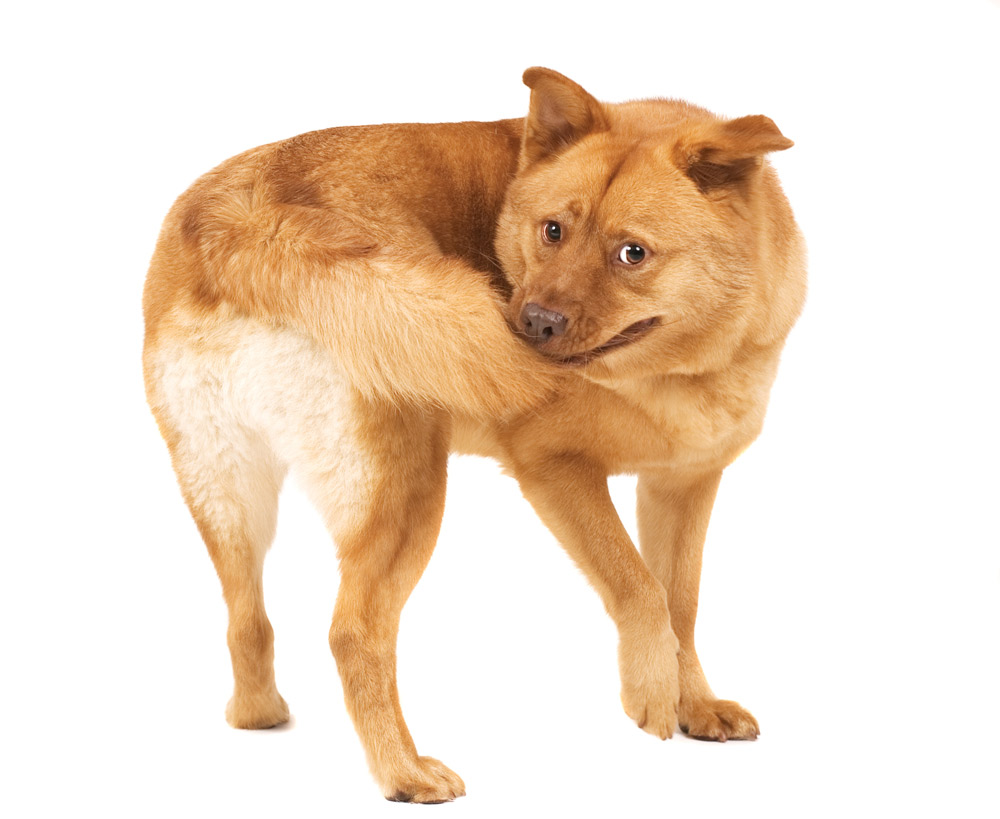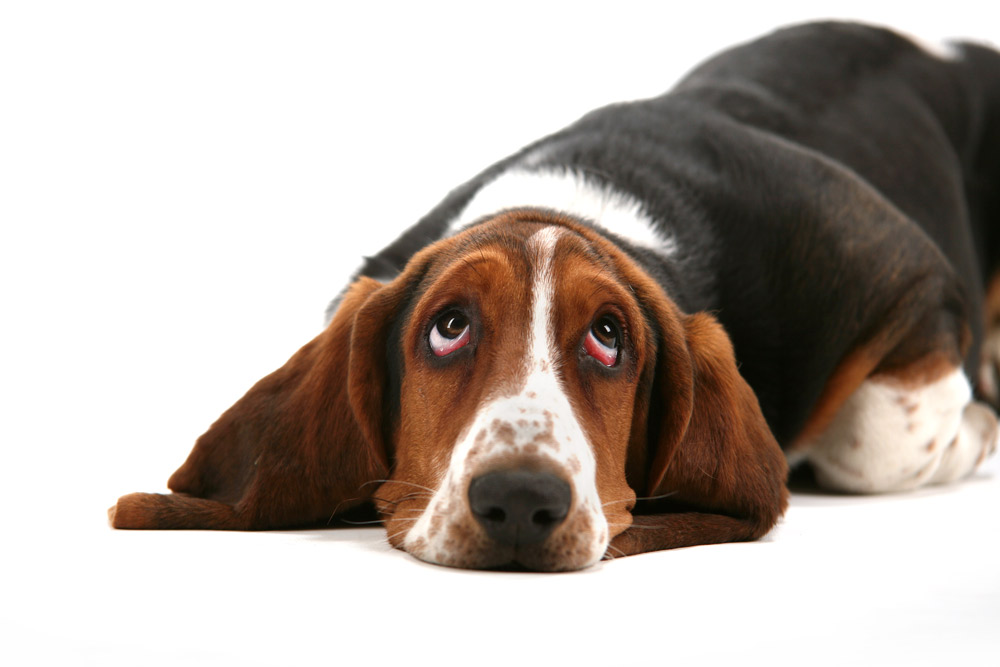Does your dog seem obsessive-compulsive? Does he do the same strange things over and over again, without apparent reason? He could have Canine Compulsive Disorder or CCD.
You might think obsessive-compulsive behaviors are only seen in humans, but dogs can exhibit them as well. There are many examples of repetitive behaviors in dogs that may be attributed to Canine Compulsive Disorder (CCD), once physical causes have been ruled out.
Here are some examples of possible CCD behaviors:
- Spinning or tail chasing — this can often be a harmless expression of excitement common in young dogs; however, tail-chasing spinning, especially in English bull terriers and German shepherds, also has a dark side and can be indicative of a neurological disorder or CCD/autism
- Flank or blanket sucking – this is a classic example of what we think of as CCD spectrum behavior; these dogs engage in “sucking” as a presumed means of “self-soothing”, an addictive behavior of sorts
- Excessive self-grooming — necessary rule-outs include acral lick dermatitis aka lick granuloma, allergies, pain, injury, etc.
- Shadow/light chasing
- Some cases of fly biting — once partial seizure is ruled out)
- Excessive licking of surfaces — gastrointestinal disturbances are an important rule-out – see page xx for more about these.
Some background info
Canine repetitive behaviors were one of the first companion animal behaviors to be considered a model for human OCD, because they bear many similarities to one another (more on these similarities in the next paragraph). In a nutshell, human Obsessive-Compulsive Disorder (OCD) is partially described as repetitive, ritualistic behaviors and distressing thoughts that are performed in excess of what is required for normal function and that interfere with normal daily activities. OCD is one of the most common neuropsychiatric disorders, affecting an estimated 1% to 3% of people.
Research has shown that CCD has many similarities to human OCD in terms of behavioral expression, age of onset, its association with stress, and brain structural homology. Even the number of animals afflicted is similar – it has been suggested that 2% to 3% of the canine population may be affected by CCD.
What causes CCD?
Unfortunately, our understanding of the causes of this disorder is limited. CCD is one of the most difficult canine behavioral disorders to successfully treat, no doubt because genetic, environmental, and neurochemical/neurophysiological elements all come into play. Here are some triggers for CCD:
- Sometimes a suboptimal environment is the primary trigger for repetitive behaviors. Traditional zoo and equine enclosures have often rightly been criticized as culprits. With our increasing awareness of animal welfare, we’ve seen alterations to these environments that often result in resolution of the behaviors, as long as they have not become engrained. When an animal is exhibiting repetitive behaviors, therefore, a close consideration of the animal’s housing arrangements and management are recommended, along with a preliminary physical examination.
- The onset of compulsive behaviors is frequently observed in juvenile to young adult dogs. In some cases, the onset appears spontaneous with no known trigger. In other cases, the initial onset may be associated with exposure to conflict, stress, frustration or boredom, although later, the behavior may be displayed out of context in other situations of high arousal.
- Some compulsive behaviors are more common in certain breeds, suggesting a genetic predisposition for developing the condition. Tail chasing is most commonly associated with bull terriers and German shepherds, while flank/blanket sucking is associated with Doberman pinschers — research is supporting a genetic basis in these two example breeds. However, while some breed predispositions are known, CCDs are not limited to certain breeds — it’s simply that some breeds appear to be more prone to developing the condition than others.
- Stress appears to exacerbate the behavior. Reported triggers associated with the onset and continued expression of CCD include a change of environment, new people, changing schedules, new children or strange sounds and sometimes physical discomfort caused by allergies or fleas.
Can CCD be harmful or dangerous?
Once the compulsive behavior cycle begins, and if it’s left untreated, the dog may continue to engage in the behavior without any additional triggers (in the case of a genetically highly predisposed dog), or any time the dog is highly aroused by social, environmental or even medical triggers. Eventually, as the behavior is repeated over and over again, the dog begins to lose control over his ability to initiate or terminate it. The behavior is then no longer regulated by exposure to “stress”, as it has become engrained. This is when the real trouble begins.
Repetitive behaviors can occupy a large percentage of a dog’s daily life and adversely affect his quality of life by interfering with eating, sleeping, exercising and his relationship with family and other animals in the household. Some dogs with CCD will retire to private areas away from family to engage in their compulsions, especially if they have been wrongfully punished for the behavior. These dogs may also retire when they are bored or stressed.
Canine CCDs are just as capable of destroying a dog’s ability to function as human OCDs are capable of affecting human lives. In the most severe cases, these dogs can’t eat, sleep, acknowledge owners, go for walks, engage in play, etc. In addition to social detachment and general dysfunction, the frequency, duration and intensity of the behavioral expression can result in self-injury. For example, tail-chasing dogs may injure their tails, wear their paw pads, and lose weight to an unhealthy degree. Flank/blanket-sucking Doberman pinschers may create open lesions on their sides from excessive mouthing and sucking and may experience intestinal obstruction from ingesting blankets/fabrics.
How can CCD be alleviated?
Because the causes of CCD aren’t completely understood, treatment can be a challenge. Current OCD therapies and pharmacological treatment for humans benefit only about half of all human patients, so much more needs to be learned from studying the similarities and differences between the expression of repetitive behaviors in humans and dogs.
CCD is a lifelong condition that may wax and wane along with prevailing stressors in the dog’s life. Treatment has mostly centered on eliminating or desensitizing the dog to stressors in his environment; the use of behavior modification strategies to interrupt and redirect the problem behavior to a more appropriate activity; and, conventionally, medication that includes but is not limited to serotonin reuptake inhibitors. A canine behaviorist is most often required to help manage the condition.
We always hope for a long-term remission, but if your dog has been diagnosed with
CCD, you need to be aware that changes in his social and environmental lives may “reignite” symptoms. CCD can be a challenge, but it’s certainly not insurmountable depending upon the severity of the dog’s symptoms and the family’s lifestyle. And the sooner you get help for any unusual behavior, the better the outcome will be!








